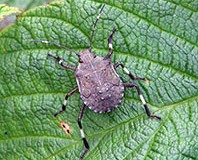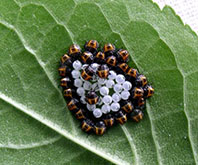Read the latest information on
Foot-and-mouth disease

Late instar nymph of brown marmorated stink bug. Photo: Gary Bernon, USDA APHIS, Bugwood.org
The Australian Department of Agriculture and Water Resources is asking people to be aware of the possibility of a new type of stink bug arriving in Australia via travellers and freight.
Brown marmorated stink bugs (BMSB; Halyomorpha halys) originate from Asia but in recent decades they have spread to North America and Europe.
They are known to affect about 300 plants including fruit, vegetables and ornamentals and are far more damaging and difficult to control than other stink bugs you may be familiar with.
Adult brown marmorated stink bugs are 12 to 17 millimetres long and mottled with a faint reddish tinge. While there are species of stink bugs in Australia that may look similar, adult brown marmorated stink bugs have distinctive black and white banding around the edge of the abdomen with white bands on the last two antennal segments.
They have the potential to severely impact agricultural production. Both juveniles and adults feed on, and can severely damage, fruit and vegetable crops.
Since 2001 when it arrived in the US, it has spread to over 40 states and added to crop production costs because of the increased need to spray to control them. They could have similar impacts if they were to arrive and become established in Australia.
In the US they seek shelter from the cold weather of Northern Hemisphere winters in crevices or protected areas of shipping containers, vehicles, boats, caravans, machinery and personal stored items.
They’re also a nuisance pest, as adults enter vehicles, homes and factories in large numbers in autumn months, looking for places to shelter over winter.
These stink bugs don’t limit their travel to the usual pathway on fruit or vegetable consignments from overseas.

Eggs and nymphs of brown marmorated stink bugs. Photo: Gary Bernon, USDA APHIS, Bugwood.org
From about September to April – the BSMB ‘season’ – they can be found in large numbers in consignments of imported new and used vehicles, vessels and machinery in shipping containers arriving in Australia. The department has implemented control measures both before products leave their country of origin and when they arrive in Australia.
They’re also known to hitch hike in packing material and personal luggage of passengers arriving from the USA and Asia in the BMSB season.
The department will continue surveillance at ports, quarantine approved premises and distribution centres from 1 September to 30 April. Pesticides and control techniques used overseas are being reviewed as a precaution.
With so many alternative pathways to enter Australia it’s important for anyone importing goods or travelling from US to keep an eye out for the brown marmorated stink bug and report it to the Exotic Plant Pest Hotline 1800 084 881.
Identification guide for brown marmorated stink bug (Halymorpha halys and other similar bugs) (Australian Department of Agriculture and Water)
Acknowledgement: This article was written from information provided by the Australian Department of Agriculture and Water Resources